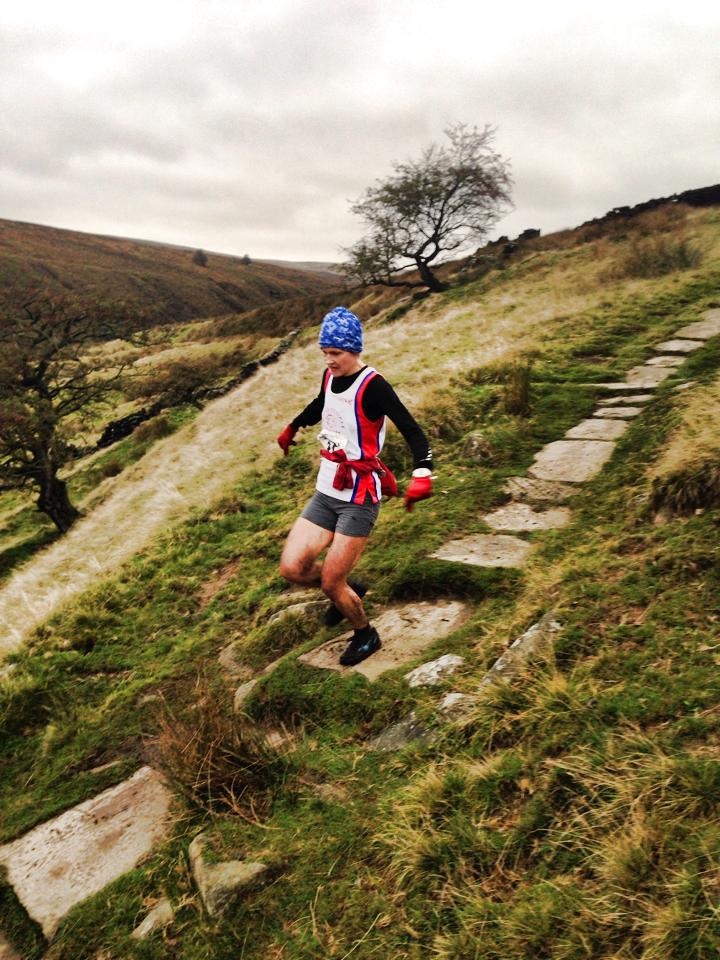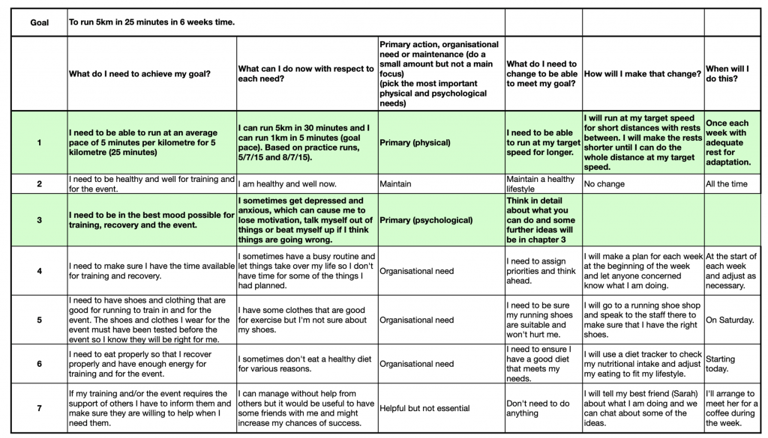How do I become a Fitter, Faster, Better Cyclist or Runner: how do I make my goal real?

Chapter 2: How do I make my goal real?
After Chapter 1 you will have
- your goal, (what you want to achieve at a certain time)
- a list of things you need to achieve that goal
- what you can do in comparison to each of those needs
- one physical need that is a priority
- one psychological need that is a priority
If you don’t have these things you may want to go back to review Chapter 1 and put these in place, alternatively you can go on with this Chapter but it is important to do each step in turn to get a really solid plan.
Did you remember?: “If you only remember one thing – remember this:”
Your body will adapt to whatever situation you place it in.
I make no apology for repeating it here and the explanation: if you go for a run your body will get better at running, if you sit on the settee your body will adapt itself to sitting on the settee and if you play darts you will get better at playing darts. If you do too much of anything your body will do things to stop you doing it, if you train too hard or too much it will break down so you are too tired to train properly.
The three principles of training are: “specificity” – you need to train specifically for what you want to achieve; “overload” – you need to stress your system to make it react and get fitter; and “regression” – if you stop doing something you will drift back to where you were (use it or lose it basically).
So let’s get started:
What was your priority physical goal?
It is a reasonable assumption that this is physically impossible for you at the moment because if it wasn’t you could just go out and complete your goal anytime you want with no need to train. The thing to do is break down what you need to do into bits and then work out how to join the bits together to meet your need.
Looking at the example in Chapter 1, ‘you need to be able to maintain your target speed for a given time or distance’.
In this example we can also assume that you can do part of the distance at the speed you need and that given enough time and maybe with rests you can complete the distance at a slower speed, even if this is over several days. In simple terms, you can solve your problem by either extending the distance that you can manage at your target speed or getting faster at your target distance.
Let’s think back to breaking it into bits again and what you can do, this works if your only objective is to complete the distance as well but it is always best to have a target time in mind (i.e. be as specific and detailed as you can). You know that you can do some of the distance at your target speed so what if you had a rest after each little bit, you could probably do a bit more time overall at your target speed. If you then made those rests a bit smaller each time you do that training session, say you do it once a week, eventually you could probably do the whole distance at the speed without resting.
Does that make sense?
In training, what we usually do is vary the speed a little bit and do the faster parts a bit faster than you would need to reach your goal. This trains your body to get used to going a bit faster, so that when you put it together with no rests it can cope because the actual speed is a little easier. What we also do is build up so that the total time at your target speed is a bit longer than your target time. For example if you want to do 100 miles then you wouldn’t try to do over 100 miles in one training session but you might decide to do over 100 miles in a weekend or a week, i.e. in smaller bits with rests.
The principle is the same.
Let’s take our example from the spreadsheet shown later on, to run 5km in 25 minutes. If you can run 1km in 5 minutes then have a rest and then do another in 5 minutes then another you have done 3km at your target speed and you can build on that as you get fitter.
Does all this make sense?
Let’s leave that for now and think about something else
Resting and adaptation
Remember again:
Your body will adapt to whatever situation you place it in.
We can now think a bit more about how this happens. What actually happens is that when we stress our bodies, with exercise for example, if it is hard enough to make a change, we are doing some damage. Our bodies don’t like this so when the damage is repaired we become a little better at doing the thing that caused the damage so that if it happens again we are more able to cope with the stress.
This is really important because if we keep applying the stress and recovering we can keep getting stronger, fitter, better at what we are doing. However, if we do too much without letting our bodies adapt then we just keep damaging ourselves, our bodies fight back and we get ill, suffer chronic fatigue or some other debilitating condition. The key message here is it is better to be safe than sorry so don’t over do it. We can think about how to avoid over doing it, using a few measures and ideas later. The key is to have enough rest and make sure that rest is proper rest.

The trick is to do each training session when your body has adapted to be a little fitter, faster, better than it was before. The graph gives a good illustration of this, each time you train, the curve dips and then builds back up as you recover. It builds up to a little higher than before you did the session so that if you train at the right time, you gradually get fitter. It is also useful to note that you don’t lose fitness as fast as you gain it so a bit of extra rest isn’t a problem. You can see in the Perfect training (green) curve, that leaving the next session until day 15 after the curve has turned down still gives a good improvement, even though day 13 would have been the ideal time to train, so having a bit of extra rest if you aren’t sure is a good thing. You would generally train more often than once a week but these timings provide a good example. Some elite athletes train several times each day but they can recovery quickly and if they are full time, can take as much time as they need to focus on recovery.
The three curves on the graph show different phases of the training, recovery and adaptation process. Train too late means that you wait until you have lost the fitness gains your body made by adapting to the previous training session, that is too much recovery. Over training is when you train before you are properly recovered, your body continues to be broken down and eventually you become ill; this shows the need for proper recovery. In perfect training, each session builds on the last and you train when your body has made fitness gains from the last session so you gradually get fitter and fitter.
There are a lot of ideas here and they aren’t really organised into a plan that you can carry out so we need to order our thinking.
Action plan
Take the list you made in Chapter 1 and for each item write down what you need to change, how you will make that change and when you will do it. Have a look at the example below and then adapt it to meet your goals. Remember that your goals are specific to you so just use the table as an example and adapt everything to your needs.
Here is my example (Primary actions are highlighted in green):

The plan in the table only has one training session, this is your most important session of the week but you would also include other runs that are easier and promote recovery as well as building efficiency. In reality you might be able to do an interval training session (item 1 in the table) twice each week and do 2 to 4 easier runs of varying distances to build your overall running fitness.
Now you have a goal and a way to achieve that goal. You also have details of what you are going to do to make sure you are organised and get enough rest so that your body adapts to what you are doing and gets stronger and fitter.
We haven’t considered the details of what to do each week or how to address the psychological needs that you have identified. One very important thing you can do to feel better psychologically is to do some exercise so between now and the next blog I suggest you get out and enjoy your sport and think about how great it will be when you meet your goal. This ‘winning image’ of how good you will feel when you succeed is a really important motivator and helps you feel great so you can practice it when you feel down, or I should say ‘if you feel down’ because I hope you won’t.
You can also try out a training session of how you are going to meet your physiological goal, if you have a running goal like the example, you can try doing a distance of about 500 metres at your race speed, have 2 to 5 minutes rest then try it again and see how many you can do before you have to slow down. Stop when you can’t keep up the speed and make a note of what you have done. This training session will be really helpful in setting up the detail of how you will meet your goal.
If your challenge isn’t to do with running, it doesn’t matter you can still break the goal into smaller chunks and build up until you can complete your challenge. If you’re stuck and need a quick suggestion get in touch or make a comment.
Also remember to have fun with your sport, in fact I hope that is why you have chosen to do it; if you aren’t finding it fun then that is definitely something to work on and I hope I can help there because it can be great fun. Just practicing will make you better so you don’t always have to work hard; you can just go out for some easy enjoyment as well. In fact this is really important physically and psychologically – just make sure you rest as well and take time to feel positive about what you are doing.
Have fun and please let me know what you think and ask if you have questions.
April 8, 2019

Comments